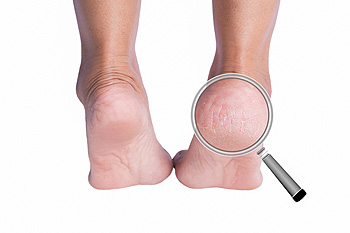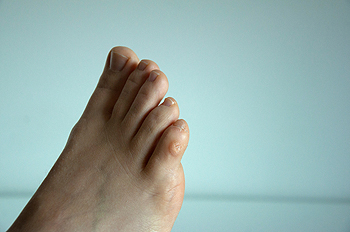Items filtered by date: March 2023
Runners and Cracked Heels

People who enjoy running can experience many benefits including increased endorphins. Conversely, avid runners may see they have developed cracked heels, which can cause pain and discomfort while making it difficult to run. There are generally four stages that runners see when developing cracked heels, which begin with their feet becoming red, sensitive, and dry. This can be followed by an itchy and burning sensation, which can lead to cracked and peeling skin. If treatment is not started, the cracks in the skin may begin to bleed, causing the feet to look unattractive. A common reason for cracked heels to develop is a lack of hydration of the skin. Cracked heels found in runners are often increased as a result of the impact of running, and from wearing socks and shoes that may become sweaty. If you have developed this foot condition, it is suggested that you consult with a podiatrist who can guide you toward the treatment method that is correct for you.
If the skin on your feet starts to crack, you may want to see a podiatrist to find treatment. If you have any concerns, contact Dan Kirk, DPM from Bluffton Foot & Ankle. Our doctor can provide the care you need to keep you pain-free and on your feet.
Cracked Heels
It is important to moisturize your cracked heels in order to prevent pain, bleeding, and infection. The reason cracked heels form is because the skin on the foot is too dry to support the immense pressure placed on them. When the foot expands, the dry skin on the foot begins to split.
Ways to Help Heal Them
- Invest in a good foot cream
- Try Using Petroleum Jelly
- Ease up on Soaps
- Drink Plenty of Water
Ways to Prevent Cracked Heels
- Moisturize After Showering
- Skip a Shower
- Keep Shower Water Lukewarm
- Don’t Scrub Your Feet
If you are unsure how to proceed in treating cracked heels, seek guidance from a podiatrist. Your doctor will help you with any questions or information you may need.
If you have any questions, please feel free to contact our offices located in Bluffton and Celina, OH . We offer the newest diagnostic and treatment technologies for all your foot care needs.
Blisters and Shoes Without Socks

Blisters can form on the feet for a variety of different reasons. Blisters, once they develop, can take form as pockets of fluid on the outer layer of the skin. Often, blisters can form on the feet in response to friction or pressure. Commonly, pain and blisters can form when an individual wears summer shoes without any socks. This can be particularly pronounced when wearing leather shoes without socks. To avoid this problem, an individual can take a number of different steps. For example, an individual can wear ankle socks which are not visible from the outside, yet they can effectively protect the feet from the development of blisters on the foot inside of the shoe. If you are someone that likes to wear shoes without any socks, it is highly suggested that you consider contacting a podiatrist to schedule an appointment.
Blisters are prone to making everyday activities extremely uncomfortable. If your feet are hurting, contact Dan Kirk, DPM of Bluffton Foot & Ankle. Our doctor can provide the care you need to keep you pain-free and on your feet.
Foot Blisters
Foot blisters develop as a result of constantly wearing tight or ill-fitting footwear. This happens due to the constant rubbing from the shoe, which can often lead to pain.
What Are Foot Blisters?
A foot blister is a small fluid-filled pocket that forms on the upper-most layer of the skin. Blisters are filled with clear fluid and can lead to blood drainage or pus if the area becomes infected.
How Do Blisters Form?
Blisters on the feet are often the result of constant friction of skin and material, usually by shoe rubbing. Walking in sandals, boots, or shoes that don’t fit properly for long periods of time can result in a blister. Having consistent foot moisture and humidity can easily lead to blister formation.
Prevention & Treatment
It is important to properly care for the affected area in order to prevent infection and ease the pain. Do not lance the blister and use a Band-Aid to provide pain relief. Also, be sure to keep your feet dry and wear proper fitting shoes. If you see blood or pus in a blister, seek assistance from a podiatrist.
If you have any questions, please feel free to contact our offices located in Bluffton and Celina, OH . We offer the newest diagnostic and treatment technologies for all your foot care needs.
Dealing With Corns on the Feet

Corns on the feet are the result of combining motion with friction. For example, a tight pair of shoes can press one of the toes against the top, side, or bottom of the shoe causing a callus or corn to form. A callus is a buildup of skin that serves to protect the foot from repetitive friction. It is rarely painful. A corn, however, can become exceedingly painful when a small seed develops within the toughened skin. There are a number of ways to remove a corn that involve acids that may burn away the layers of skin, but it is best to seek the help of a podiatrist before trying these at home. The podiatrist can examine the cause of the corn and recommend the proper treatment option. In some cases, it may be necessary to have orthotic devices or arch supports made specifically for your foot, as in the case of overpronation or arch problems. In addition, the podiatrist may recommend toe separators, toe straighteners, or toe caps to relieve the pressure from friction, along with guidelines on proper footwear. If you have developed a corn on the foot, it is suggested that you consult with a podiatrist for safe treatment and removal options.
If you have any concerns regarding your feet and ankles, contact Dan Kirk, DPM of Bluffton Foot & Ankle. Our doctor will treat your foot and ankle needs.
Corns: What Are They? and How Do You Get Rid of Them?
Corns can be described as areas of the skin that have thickened to the point of becoming painful or irritating. They are often layers and layers of the skin that have become dry and rough, and are normally smaller than calluses.
Ways to Prevent Corns
There are many ways to get rid of painful corns such as wearing:
- Well-fitting socks
- Comfortable shoes that are not tight around your foot
- Shoes that offer support
Treating Corns
Treatment of corns involves removing the dead skin that has built up in the specific area of the foot. Consult with Our doctor to determine the best treatment option for your case of corns.
If you have any questions please feel free to contact our offices located in Bluffton and Celina, OH . We offer the newest diagnostic and treatment technologies for all your foot and ankle needs.
Treatment of Foot Ulcers

A foot ulcer is any open sore on the foot. Such a sore may be on the surface of the skin or extend down to the tendons and bones. While commonly associated with diabetes, foot ulcers can arise from other various sources. Those with poor circulation, abnormalities in the bones or muscles of the feet, and skin cancer can develop foot ulcers that can become infected, are difficult to heal, and can have serious consequences for one’s health. An untreated infection can turn into an abscess or pocket of pus, cellulitis, a bone infection, or gangrene. It is suggested that you examine your feet daily and see a podiatrist as soon as possible if you notice an open sore on your foot.
Wound care is an important part in dealing with diabetes. If you have diabetes and a foot wound or would like more information about wound care for diabetics, consult with Dan Kirk, DPM from Bluffton Foot & Ankle. Our doctor will assess your condition and provide you with quality foot and ankle treatment.
What Is Wound Care?
Wound care is the practice of taking proper care of a wound. This can range from the smallest to the largest of wounds. While everyone can benefit from proper wound care, it is much more important for diabetics. Diabetics often suffer from poor blood circulation which causes wounds to heal much slower than they would in a non-diabetic.
What Is the Importance of Wound Care?
While it may not seem apparent with small ulcers on the foot, for diabetics, any size ulcer can become infected. Diabetics often also suffer from neuropathy, or nerve loss. This means they might not even feel when they have an ulcer on their foot. If the wound becomes severely infected, amputation may be necessary. Therefore, it is of the upmost importance to properly care for any and all foot wounds.
How to Care for Wounds
The best way to care for foot wounds is to prevent them. For diabetics, this means daily inspections of the feet for any signs of abnormalities or ulcers. It is also recommended to see a podiatrist several times a year for a foot inspection. If you do have an ulcer, run the wound under water to clear dirt from the wound; then apply antibiotic ointment to the wound and cover with a bandage. Bandages should be changed daily and keeping pressure off the wound is smart. It is advised to see a podiatrist, who can keep an eye on it.
If you have any questions, please feel free to contact our offices located in Bluffton and Celina, OH . We offer the newest diagnostic and treatment technologies for all your foot care needs.

